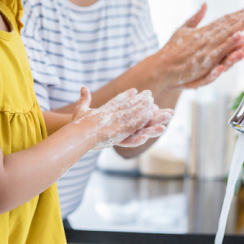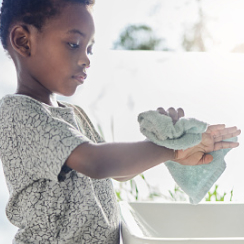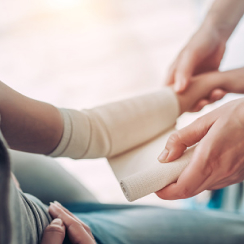


How Do I Care For Blisters?
EB requires a multidisciplinary team of physicians, nurses, and therapists. These professionals can help show you how to safely drain and care for blisters before they get too large. They can also recommend products and ways to keep the skin moist, reduce blistering, and help prevent infection. Please find links below to more information from debra of America and the EB Research Partnership at McKesson Patient Care Solutions for Newborns with EB.
Blister & Bandage Care Recommendation:1-3

Find activities that will help to distract small children such as a favorite toy, music, or videos to watch on a phone or tablet. Make this routine as calm and comforting as possible.

Ask about a blister lancing kit. Puncturing a blister when it’s small can reduce spreading. Briefly, puncture each new blister in two spots using a sterile needle. Allow it to drain but do not remove the skin forming the roof of the blister. This blister roof helps protect and heal the underlying skin.

If skin is hot to the touch, there is pus or lines spreading from the blister, speak with your doctor about a prescription for antibiotics.

Wash or sanitize your hands prior to touching open blisters or wounds especially when changing dressings.

Mild soaps and lukewarm water.

Heat and sweating can make blistering worse.

Find activities that will help to distract small children such as a favorite toy, music, or videos to watch on a phone or tablet. Make this routine as calm and comforting as possible.

Wash or sanitize your hands prior to touching open blisters or wounds especially when changing dressings.

Ask about a blister lancing kit. Puncturing a blister when it’s small can reduce spreading. Briefly, puncture each new blister in two spots using a sterile needle. Allow it to drain but do not remove the skin forming the roof of the blister. This blister roof helps protect and heal the underlying skin.

Mild soaps and lukewarm water.

If skin is hot to the touch, there is pus or lines spreading from the blister, speak with your doctor about a prescription for antibiotics.

Heat and sweating can make blistering worse.
Many individuals with EBS find that excessive bandaging may actually lead to more blistering, presumably as a result of increased heat and sweating. Many individuals have found dusting the affected areas with cornstarch, Zeasorb®, or even Desitin®, helps to dry out the skin and reduce friction. This is often followed by a single layer dressing (often foam or gauze products) followed by a simple (i.e., one-layer) dressing. 4,5
Three layer dressings (typically used for all EB types)
The first layer should be a non-adherent dressing that will not stick to the top layers of the epidermis along with a nonirritating moisturizer (e.g., Aquaphor® or petrolatum).
The second layer helps absorb wound drainage, stabilizes the nonadherent dressing, and helps pad the skin against further injury allowing for more activity.
The third layer has elasticity to it to help further secure the other bandage layers in place. Examples include: Coban™ or BandNet®.

A combination of NSAIDs (e.g., ibuprofen) and opioids (e.g., oxycodone) can help manage pain, especially surrounding activities such as walking or dressing changes. Consult your or your child’s medical professional for proper pain management regimens.
Many individuals with EBS find that excessive bandaging may actually lead to more blistering, presumably as a result of increased heat and sweating. Many individuals have found dusting the affected areas with cornstarch, Zeasorb®, or even Desitin®, helps to dry out the skin and reduce friction. This is often followed by a single layer dressing (often foam or gauze products) followed by a simple (i.e., one-layer) dressing. 4,5
Three layer dressings (typically used for all EB types)
The first layer should be a non-adherent dressing that will not stick to the top layers of the epidermis along with a nonirritating moisturizer (e.g., Aquaphor® or petrolatum).
The second layer helps absorb wound drainage, stabilizes the nonadherent dressing, and helps pad the skin against further injury allowing for more activity.
The third layer has elasticity to it to help further secure the other bandage layers in place. Examples include: Coban™ or BandNet®.

A combination of NSAIDs (e.g., ibuprofen) and opioids (e.g., oxycodone) can help manage pain, especially surrounding activities such as walking or dressing changes. Consult your or your child’s medical professional for proper pain management regimens.
References

